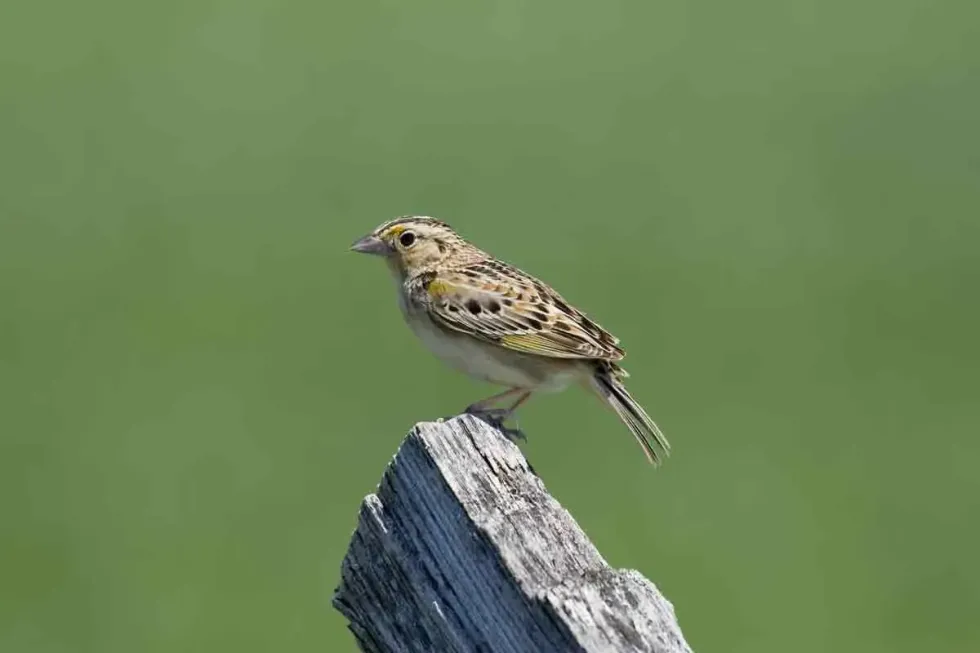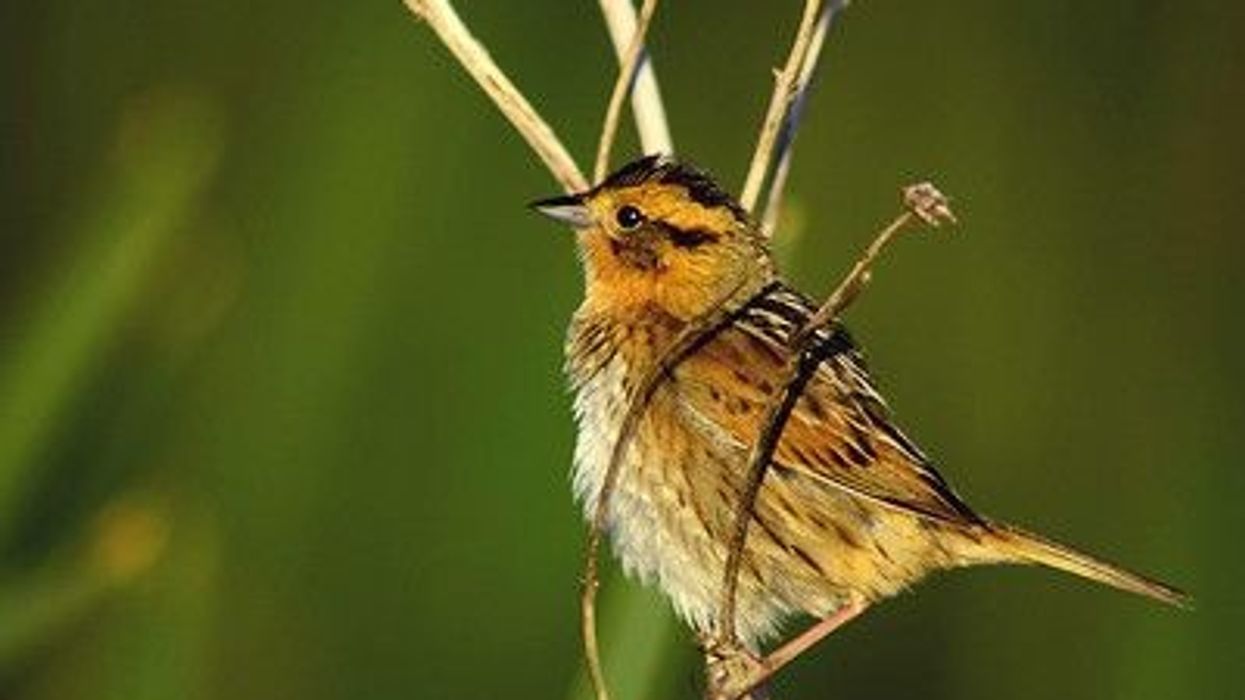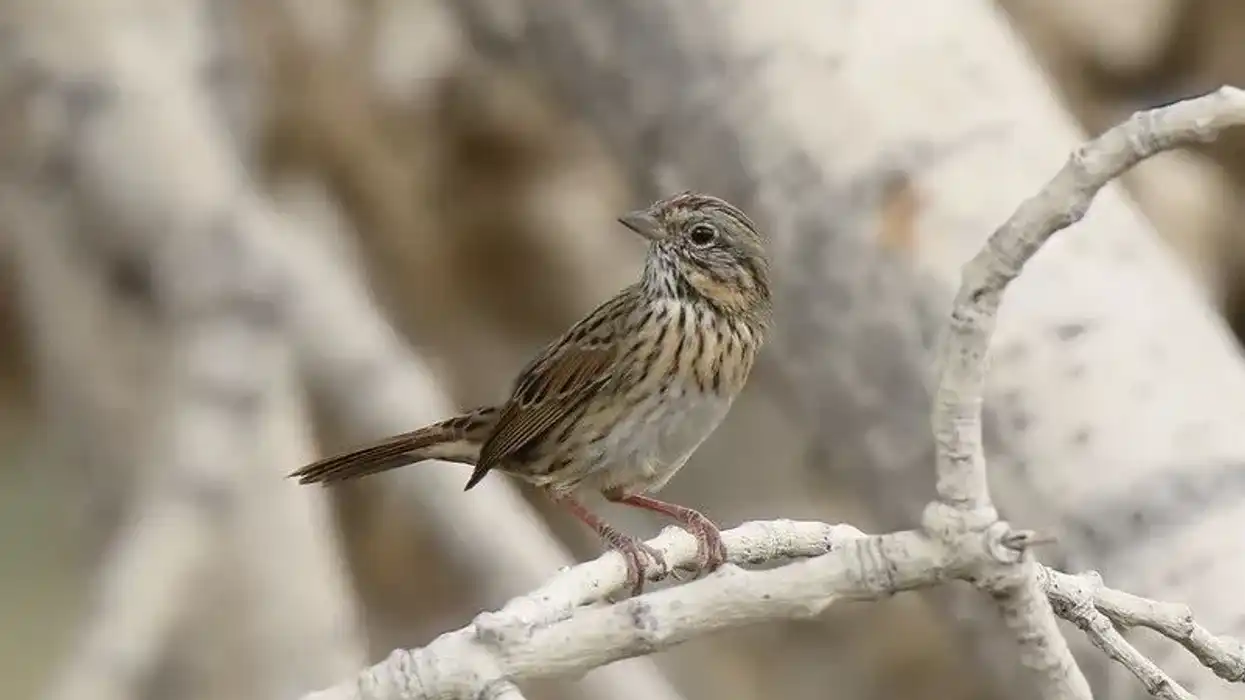The grasshopper sparrow bird belongs to the Passerellidae family and it is a species of North American birds. It is a small and lightweight bird.
However, it is considered big-headed compared to other bird species and has a streaked black and brown-colored back.
It inhabits a range of habitats and it is widely spread across the North American states, as well as Canada and Mexico.
Even though it has a conservation status of Least Concern, its population has been declining at a constant rate (it is approaching the endangered category gradually), with New York taking the worst hit of all in recent years.
One subspecies of the grasshopper sparrow bird, known as the Florida grasshopper sparrow, is under the Endangered category, with a population of only 50-60 approximately.
This bird prefers to live in the wild in open grasslands that have tall grasses for cover and plenty of seeds with insects buzzing around. Males are often heard singing their flight song during the breeding season to attract females It is a migratory bird that travels towards Central America and Mexico during winter.
Let's take a look at some grasshopper sparrow bird facts and information, and if you enjoy these then, do read about other bird species such as the savannah sparrow and the Eurasian tree sparrow.
Grasshopper Sparrow Interesting Facts
What type of animal is a grasshopper sparrow?
The grasshopper sparrow (Ammodramus savannarum) is a species of North American birds.
What class of animal does a grasshopper sparrow belong to?
The grasshopper sparrow belongs to the Aves class of animals, which means that it is a bird.
How many grasshopper sparrows are there in the world?
There are about 31 million grasshopper sparrows living around the world. However, populations are seen to be decreasing at a fast pace.
Where does a grasshopper sparrow live?
Grasshopper sparrows live in open grassland, pastures, and prairies. They build their nests in tallgrass prairies in order to hide them from predators. It is a species of North American birds that is widely spread across almost all parts of America.
What is a grasshopper sparrow habitat?
Grasshopper sparrows prefer living in prairies, savannas, pastures, and open grassland. Their habitat is widely spread over Mexico, Canada, Florida, southern British Columbia, and Central America. These grasslands provide plenty of seeds and insects, such as grasshoppers, to feed on, making grassland the most suitable habitat for a grasshopper sparrow.
Who do grasshopper sparrows live with?
Grasshopper sparrows are known to live in pairs, although there have been reports of a male living with more than one female mate at a time. During the breeding season, males are often seen singing their flight song to attract females.
How long does a grasshopper sparrow live?
Grasshopper sparrows can live up to nine years in the wild, but that, as a matter of fact, is a rare situation. They usually live only for three or three and a half years.
They are smart birds as they do not go to their nest directly after venturing out. Instead, they land at a safe distance and move through the tall grasses towards the entrance of their nest to avoid any predators following them and find their nest.
How do they reproduce?
Males perform a flight song to attract females for mating. These birds usually breed twice a year and sometimes three times.
For northern populations, the breeding season is between May and August. Males search and form their territory, and the pair builds a nest in tall grasses together, just one or two inches above the ground. The female lays four to five eggs which hatch after about 11 to 12 days.
Young nestlings leave the nest six to nine days after hatching. Grasshopper sparrow eggs are white with some reddish-brown speckles.
What is their conservation status?
The grasshopper sparrow (Ammodramus savannarum) bird has the conservation status of Least Concern. According to a report made by the Cornell Lab of Ornithology, there are around 31 million grasshopper sparrows alive in the world currently.
Grasshopper Sparrow Fun Facts
What do grasshopper sparrows look like?
Grasshopper sparrows have brown and streaked black-colored feathers on their back, along with a plain white-colored belly and breast. A yellow plumage is present on their face that surrounds their eyes, and they have a dark-colored crown. They are considered big-headed when compared to other bird species and have a short tail.
How cute are they?
Grasshopper sparrows are cute small birds that are found in open grasslands and prairies in Florida, Canada, and many parts of the United States. Their small size makes them adorable and cute.
How do they communicate?
Grasshopper sparrows, like their name suggests, make insect-like sounds to communicate with each other. Pairs often sing and perform songs using lots of squeaky notes that help when bonding. This bird also sings 'chips' or 'tsip' notes as an alert sound.
How big is a grasshopper sparrow?
A grasshopper sparrow bird is about 4.3-4.5 in (10.8-11.5 cm) in length, which is almost double the size of grasshoppers, their main food source. Like all other sparrows, this bird is quite small and harmless and has to remain alert in order to stay safe and avoid any trouble from its predators.
How fast can a grasshopper sparrow fly?
The speed at which a grasshopper sparrow can fly is not known. We do know that they build their nest in tall grass just above the ground and usually walk towards their nest instead of flying. They also hover or fly in a fluttering manner to attract a mate.
How much does a grasshopper sparrow weigh?
A grasshopper sparrow (Ammodramus savannarum) is a small and lightweight bird. It only weighs around 0.5-0.7 oz (14-20 g).
What are their male and female names of the species?
Male and female grasshopper sparrows do not have separate names.
What would you call a baby grasshopper sparrow?
Baby grasshopper sparrows can be referred to as nestlings or young birds. These young birds usually leave their nests six to nine days after hatching.
What do they eat?
They are omnivores. This means that they eat insects such as spiders, grasshoppers, and other invertebrates such as caterpillars. Their food also consists of various types of seeds such as panic grass and sedges.
Are they dangerous?
Grasshopper sparrows are not dangerous. Their habitat includes open grasslands and savannas so they usually stay away from humans. They are not at all dangerous to human beings and are totally harmless.
Would they make a good pet?
As they are migratory birds, they do not make good pets.
Did you know...
Grasshopper sparrows have an interesting behavior where they do not fly directly into their nests. Instead, they land on the ground at a safe distance from their nests and then walk or hop into the tall grass towards their nests. They use the cover of these tall grasses in order to avoid any threats or predators finding their nest.
During the breeding season, males arrive earlier than females on the breeding grounds in search of claiming a suitable territory. After the male finds a suitable territory, the pair build a nest together to lay eggs and take care of their young in. Their eggs are white-colored with reddish-brown speckles.
These birds usually do not fly straight. They fly in a zig-zag pattern before heading into the cover offered by tall grasses so that they can lose any threats following them towards their nests.
Even though grasshopper sparrows have a conservation status of Least Concern, certain subspecies are actually endangered. The Florida grasshopper sparrow is one of those species as it has a conservation status of Endangered.
According to the Cornell Lab of Ornithology, their populations are actually quite low, and only about 50-60 of them are left in the wild. This species is endangered as a result of devastating habitat loss.
Do grasshopper sparrows migrate?
They are a species of migratory birds. They migrate towards the south to Mexico and Central America during winter.
What does a grasshopper sparrow sound like?
As their name suggests, a grasshopper sparrow sings insect-like 'zeeeee' sounds. This species has two main types of sounds. Their primary song consists of notes which sound similar to insects, as mentioned before. Their secondary song consists of squeaky notes.
These birds sing this song with the motive of attracting a partner. A breeding pair often sings together both their primary as well as their secondary songs to strengthen their bond. Singing is an important mode of communication for these birds.
Here at Kidadl, we have carefully created lots of interesting family-friendly animal facts for everyone to discover! Learn more about some other birds, including the laughing gull or the Nicobar pigeon
You can even occupy yourself at home by drawing one on our grasshopper coloring pages.










